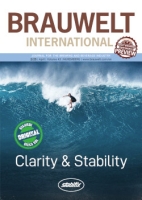This article introduces a new software solution, the “Virtual Expert”. The products, virtual Filtermanager and Lautermanager, developed by gimbio, have been operating successfully at InBev in Munich (Franziskaner Weißbier, Löwenbräu and Spaten). Average lautering time was shortened by more than ten minutes, while quality and yield were simultaneously improved. Kieselguhr consumption during filtration was reduced by 20 percent, running times were extended by 50 percent.
Filtrox AG, St. Gallen, Switzerland, a manufacturer active in the field of micro-filtration since 1938, is the leading supplier of high-quality candle filters to the global brewing industry. In recent years, Filtrox AG experienced a growing demand for this type of conventional, but reliable, filters in countries characterised by a strong increase in beer consumption – for example China. China is one of the fastest growing beer markets in the world, with the beer output holding the first position for 4 years in a line. In 2006, the beer output of the country was 351.5 million hectolitres, increasing by 14.7 percent in the previous year. Large-scale breweries accomplished CNY 83.88 billion sales revenue in the year, up 16.37 percent, while the gross profit reached CNY 3.676 billion [1].
The Research Centre Weihenstephan for Brewing and Food Quality has developed a method, based on physical chemistry, for rapid and reliable assessment of colloidal stability by analysing the streaming current potential and surface charge density of particles in filtered beers [1]. In food analysis, this measuring technology is successfully used for fining of fruit juices [2], for gushing control in sparkling wine production [3] and to determine the influence of clarifying agents on particle charge in beer [4]. Only the surface charge density of particles has been hitherto determined with this method. The new charge titration method developed by Titze & Ilberg additionally makes it possible to reproducibly measure the streaming potential [1]. This first part presents the fundamentals in a simplified manner. In Part 2, possibilities of using this method in the brewing industry will be described.
Presently, kieselguhr filtration of beer is the most commonly used technology worldwide. Due to the growing problems with this filter aid, mainly concerning worker health and kieselguhr disposal, many alternatives have been investigated. Especially small and medium-sized breweries need solutions that allow existing equipment to be retrofitted. In the last decades, occasional articles treating the filtration of beer using cellulose fibres have been published. The properties of filter aids consisting exclusively of cellulose have been investigated as well as the properties of mixtures of cellulose and other filter aids. A lot of knowledge has thus been acquired. Pre-coat filtration of beer by cellulose is possible. The beer has to be well pre-clarified..
If you supply the world market with PVPP as BASF does, you may congratulate yourself upon the fact that about every third beer the world over has been in contact with Divergan®. For decades, BASF’s Divergan has made sure that there is nothing left in the beer to spoil consumers’ expectations. Spinning the concept further, BASF has now employed the tag line “It’s a clear choice“ to promote its new beer filtration aid Crosspure®. Brauwelt International met Gero Spika, Head of Global Sales Management, Beverages Processing Polymers.
In order to produce high quality foods and beverages, the addition of a final sterile filtration step directly prior to filling is now the status quo at many filling plants.
Haze measurement is an important step in quality control in brewing of natural beers or weissbier. Use is currently made of calibrated photometers for determining the respective haze value of beer in accordance with the EBC (European Brewery Convention). This measurement simply provides a single still picture of haze and thus allows conclusions to be drawn on long-term haze stability to a limited extent only.
The favorable combination of easy sample preparation and rapid, economical analysis has contributed to the popularity of this spectroscopic method in recent years. This has resulted in its selection by many in the food industry for analysis applications. In particular, it is being increasingly utilized in facilities which produce or process malt (Fig. 1).
For some years now, membrane beer filtration has been one of the major topics of discussion in the brewing industry, offering a new technology that overcomes the negative impact of kieselguhr (KG) to the environment and human health. The AlfaBright™ technology is based on the combination of a high speed separator and a membrane cross-flow filter system with flat sheet membranes. In this report the setup and results of the AlfaBright™ membrane filtration process will be discussed.
A proline-specific protease preparation has been commercially available from DSM Food Specialties since 2005. Called Brewers Clarex™, this product is a highly concentrated solution of a food grade, acid stable enzyme that exhibits a strong preference for cleaving protein chains next to proline residues. The enzyme is added during the primary fermentation phase and is currently marketed as an alternative to PVPP and/or silica treatments. The efficacy of the enzyme is illustrated by the fact that quantities of not more than two ml/hl wort are required to prevent chill haze formation and to produce beers that are completely stable.
Dr.-Ing. Martina Gastl (nee Schütz), Dr. rer. nat. Dipl.-Ing. Klaus Hartmann, Dr. rer. nat. Dipl.-Ing. Markus Herrmann, Dr.-Ing. Matthias Keßler, Dr.-Ing. Stefan Kreisz, Dr.-Ing. habil. Martin Krottenthaler, Dr. rer. nat. Dipl.-Ing. Ralf Mezger, Dr.-Ing. Mark Schneeberger, Dr.-Ing. Frithjof Thiele, Dipl.-Ing. (FH) Martin Zarnkow, Univ.-Prof. Dr.-Ing. habil. Werner Back, Faculty of Technology of Brewery I, Scientific Centre for Nutrition, Land Use and Environment, Technical University Weihenstephan, Freising


